Hasegawa 1/48 P-40F Warhawk (conv)
|
KIT #: |
09843 |
|
PRICE: |
On sale now at HLJ for 1,300 yen!
(Get ‘em while you can) |
|
DECALS: |
Two Options |
|
REVIEWER: |
Tom Cleaver |
|
NOTES: |
AMTech P-40F resin nose; Aires P-40E
cockpit; Cutting Edge PYND48023 “Curtiss Cuties Part 1" (most long OOP) |
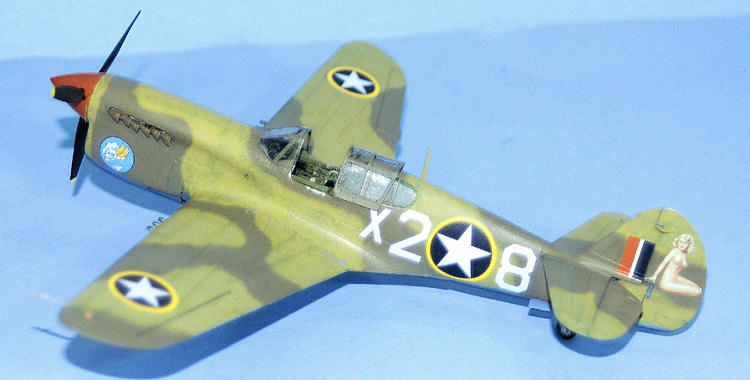
The P-40 was always at a disadvantage due to the altitude performance
restrictions of the non-supercharged Allison engine. In 1941, as Packard began
producing the Merlin 28 with a single-stage supercharger, Curtiss decided to
change power plants from the Allison to the Merlin. The result was the P-40F and
P-40L.
The main visual difference between these two sub-types and others was the
lack of the carburetor intake on the upper cowling, and an overall more "squarish"
look to the cowl. The P-40F-1 was produced with the short fuselage, which was
changed from the P-40F-5 onwards to the extended fuselage which was designed to
deal with a lack of directional stability associated with the shorter fuselage.
The P-40F entered production just prior to the attack on
Pearl
Harbor.
The first Fighter Group to equip with the P-40F was the 57th Fighter
Group, which was originally equipped with "short-tail" P-40F-1s.
The unit was sent to
Egypt
in the Summer of 1942 to reinforce the RAF and allow the American pilots to gain
valuable combat experience as a part of the 9th
U.S.
Army Air Force.
Operationally, it was found that the single-stage supercharger did not
provide the P-40F with a major increase in high-altitude performance, though
best altitude was increased from 10,000 ft to 15,000 ft. Given the altitudes at
which combat took
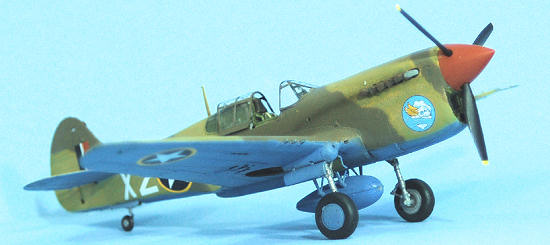 place in
North Africa,
the airplane was not at a disadvantage so long as there were Spitfire escorts
around. Otherwise, P-40F pilots - like their Commonwealth counterparts in
Allison-powered P-40s - invariably found the enemy above them.
place in
North Africa,
the airplane was not at a disadvantage so long as there were Spitfire escorts
around. Otherwise, P-40F pilots - like their Commonwealth counterparts in
Allison-powered P-40s - invariably found the enemy above them.
The 57th Fighter Group had as its primary task ground support
of the 8th Army during the westward advance from
Egypt
following the
Battle
of El-Alamein. The most well-known action came on
April 17, 1943,
when the 57th FG participated in "Bloody Sunday", the massacre of a
large formation of Ju-52s carrying supplies from
Sicily
to Rommel's forces in
Tunisia.
The second unit to deploy to North Africa immediately after the 57th
FG was the 79th Fighter Group, which arrived in Egypt in October
1942, just before the battle of El-Alamein.
Although the unit was not combat-ready at the
time of El-Alamein, many pilots flew combat missions with both RAF Kittyhawk
units and the 57th FG to gain combat experience until the 79th
FG began independent operations in March 1943. During the Spring and Summer of
1943, the 79th took part in the major operations in the
Mediterranean, escorting bombers, attacking enemy shipping, and supporting
ground forces at the end of the war in Tunisia, the reduction of Pantelleria,
and the invasions of Sicily and Italy, following their transfer to 13th
Air Force that August. The 79th
received a Distinguished Unit Citation for its support of the British Eighth
Army during the period, March–August 1943.
The 79th FG continued to operate P-40F and P-40L fighters for
tactical air support on the front lines until March 1944, participating in the
Anzio
invasion during January-March 1944.
In April 1944, the 79th re-equipped with the P-47 Thunderbolt.
Perhaps the best-known of the original squadrons assigned to the 79th
was the 85th Fighter Squadron, which decorated the rudders of their
P-40s with some of the most stunning pin-up artwork displayed by any unit during
the war before being told to “clothe” the rudder ladies in December 1943.
From October 1943 to March 1944, the 79th FG was assigned a
fourth fighter squadron, the 99th Fighter Squadron known to history
as the “Tuskeegee Airmen.”
Originally formed first fighter squadron manned by African-American, the
squadron was reluctantly sent overseas by the USAAF in the Spring of 1943, with
an original assignment to provide air defense over
Liberia
in equatorial
Africa,
an assignment far from the major area of operations.
After protests made their way to the White House, where
 Eleanor
Roosevelt personally question USAAF Commanding General H.H. Arnold about the
assignment, the 99th Fighter Squadron, under the command of Major
Benjamin O. Davis, was assigned to the Mediterranean Theater as an “independent”
squadron. They were initially
attached to the 33rd Fighter Group, where they experienced difficulty
getting cooperation from the group’s leadership.
That July they were assigned to the 324th FG, where the
Commanding Officer refused to allow pilots from the 99th to take part
in operational briefings, then criticized their combat performance.
They were finally assigned to the 79th Fighter Group in
October 1943, where all these problems were resolved.
Along with the rest of the 79th FG, the 99th FS
gave close air support to 5th Army in its assault on Foggia and then
to the French and Polish armies during their attack on Monastery Hill near
Cassino. During these campaigns,
pilots frequently flew more than five missions a day, culminating in a major
strike on Capodichino Airdrome outside
Naples
in December.
Eleanor
Roosevelt personally question USAAF Commanding General H.H. Arnold about the
assignment, the 99th Fighter Squadron, under the command of Major
Benjamin O. Davis, was assigned to the Mediterranean Theater as an “independent”
squadron. They were initially
attached to the 33rd Fighter Group, where they experienced difficulty
getting cooperation from the group’s leadership.
That July they were assigned to the 324th FG, where the
Commanding Officer refused to allow pilots from the 99th to take part
in operational briefings, then criticized their combat performance.
They were finally assigned to the 79th Fighter Group in
October 1943, where all these problems were resolved.
Along with the rest of the 79th FG, the 99th FS
gave close air support to 5th Army in its assault on Foggia and then
to the French and Polish armies during their attack on Monastery Hill near
Cassino. During these campaigns,
pilots frequently flew more than five missions a day, culminating in a major
strike on Capodichino Airdrome outside
Naples
in December.
On
January 24, 1944,
during a morning mission led by Capt. Clarence Jamison over the
Anzio
beachhead, five enemy aircraft were shot down, followed by three more that
afternoon by Lt. Wiley’s flight.
This was followed on January 25 by claims for four more.
On February 5th , Lt. Driver claimed another and on February 7th
three more were claimed.
Following their combat success during the
Anzio
invasion, the 99th FS
received an official commendation from General Arnold.
In April, 1944, the 99th FS transferred back to the 324th
FG, where there were no more difficulties for the combat-proven pilots as
they took part during May 1944 in “Operation Strangle,” the air campaign to
isolate the German garrison at Monte
Cassino.
At the end of May the 99th was assigned to the 332nd
Fighter Group, which these pilots considered a retrograde assignment, since they
had been operating with racially-integrated units prior to being assigned to a
segregated unit.
The P-40M was the first “long-tail” kit released by Hasegawa in their
P-40 series. The kit was originally
released as a Kittyhawk
III
with RAF markings and and additional option for the P-40K short tail.
This “Finnish Air Force Edition” is one of the limited-releases with
different decals, providing markings for a Red Air Force P-40M flown from
Archangel
that was captured and flown by the Finns in 1944. For a complete preview,
follow this link.
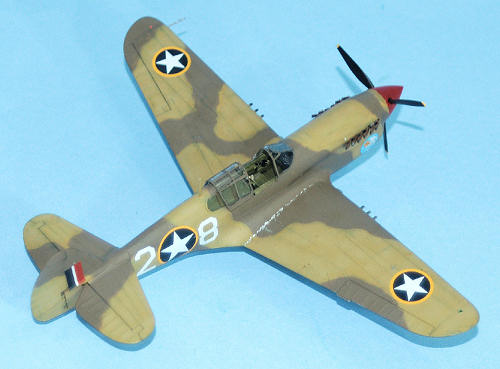 It continues to amaze me that Hasegawa has released every major version
of the P-40 from the E on, with the exception pf the P-40F.
What surprises me about this is that the P-40F is likely the most popular
P-40F sub-type besides the P-40E among modelers.
It would take reworking the forward fuselage halves and the lower wing
center section, along with different radiator parts, to create a P-40F.
Interestingly, the sprue breakdown shows this would not be hard.
It continues to amaze me that Hasegawa has released every major version
of the P-40 from the E on, with the exception pf the P-40F.
What surprises me about this is that the P-40F is likely the most popular
P-40F sub-type besides the P-40E among modelers.
It would take reworking the forward fuselage halves and the lower wing
center section, along with different radiator parts, to create a P-40F.
Interestingly, the sprue breakdown shows this would not be hard.
Fortunately, AMTech released a P-40F back in 2002 that was a re-release
of the
AMT
kit. That kit was notorious for
having the cowling wrong for the P-40F, and I was able to convince Alan
Griffiths to release a corrected resin nose for the kit, based on some other
aftermarket conversion sets that were then out of production by companies that
no longer existed. It was a pretty
simple conversion to take a razor saw to the kit and attach the new nose, with a
minor modification to the forward center section of the lower wing. Having a
couple extra of these noses, I took a look at the Hasegawa kit and realized it
wouldn’t be any more difficult to make the conversion here too.
Cutting Edge did a series of “Pyn-Up” decals in limited editions back
around 2003-2005, among which was a sheet 48023 “Curtiss Cuties Part 1" that
included a P-40F of the 79th FG, 85th FS, with one of the
striking pin-up girls done very well.
Additionally, I had an Aires resin cockpit for the P-40E which differed
from the P-40F only in needing to use a different instrument panel, which is the
same as provided in the P-40M kit.
As with most Hasegawa P-40s, construction begins by attaching the
rear fuselage halves to the forward fuselage halves before further assembly,
so one can work the fit from both inside and outside and get it as tight as
possible, which will make the elimination of this seam much easier down the
line.
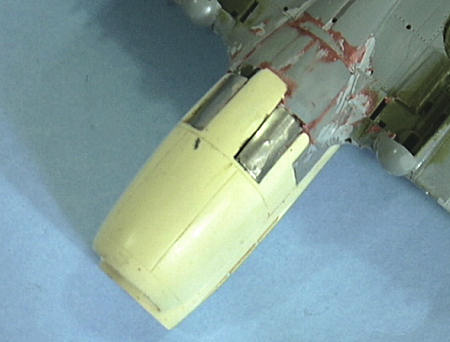 I also assembled the wing and worked on the attachment of the guns so
that I could apply Tamiya “Mr. Surfacer” to get rid of those attachment seams.
I also assembled the wing and worked on the attachment of the guns so
that I could apply Tamiya “Mr. Surfacer” to get rid of those attachment seams.
I then cut the molding block off the resin conversion part and checked
its fit to the fuselage before cutting the nose off the kit.
The cuts are done along panel lines, which makes this easier.
When this was done, I assembled the fuselage and attached the resin nose
and the rear canopy area. I then
applied cyanoacrylate glue to the seams of the nose and the rear fuselage and
canopy area, and sanded these smooth when it was dry.
I saw I was going to need some additional putty on the top line of the
fuselage nose to get it straight, so applied some Bondo touch-up putty and
sanded it smooth. I then applied Tamiya Surfacer to these areas and sanded them
when dry. When all was completed, I
rescribed the panel lines as necessary.
Test-fitting of the wing sub-assembly to the fuselage showed that the
area of the forward lower center section was going to need more modification.
I used the remains of the kit lower nose for this, cut to fit and
utilizing the curved shape. More
putty and then Tamiya Surfacer was needed here and I ultimately decided I would
do the cowling with the flaps and lower exhausts closed up in the interest of
making things a little easier.
I then painted and assembled the resin cockpit and attached it in
position. With that done, I
attached the wing to the fuselage and then filled in the upper wing/fuselage
joint and smoothed it.
Painting:
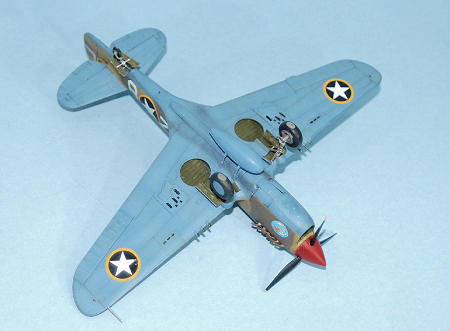 Color photos in one of Jeff Ethell’s “World War II In Color” books shows
that the long-tail P-40Fs were painted in British desert colors: dark earth and
mid stone upper surface and azure blue lower surface.
This makes sense, since Curtiss was using DePont RAF colors for their
Lend-Lease airplanes. Modelers have
pointed to other P-40Fs in “Desert Pink,” but these are all short-tail P-40Fs of
the 57th FG, and were likely delivered to the unit in Olive
Drab/Neutral Grey, with the “Desert Tan” (which later faded to “pink”) applied
at the unit level when they were transferred overseas in the summer of 1942.
Color photos in one of Jeff Ethell’s “World War II In Color” books shows
that the long-tail P-40Fs were painted in British desert colors: dark earth and
mid stone upper surface and azure blue lower surface.
This makes sense, since Curtiss was using DePont RAF colors for their
Lend-Lease airplanes. Modelers have
pointed to other P-40Fs in “Desert Pink,” but these are all short-tail P-40Fs of
the 57th FG, and were likely delivered to the unit in Olive
Drab/Neutral Grey, with the “Desert Tan” (which later faded to “pink”) applied
at the unit level when they were transferred overseas in the summer of 1942.
I used Xtracrylix RAF “Cark Earth,” “Middle Stone” and “Azure Blue,”
applied freehand. When dry I sealed
the model with Xtracrylix Gloss Varnish.
Decals:
The Cutting Edge Pyn-UP decals were used without problem.
Final Finish:
I “dinged” the model with Tamiya “Flat Aluminum” and did exhaust and oil
stains with Tamiya “Smoke.” The
canopy was unmasked, the wheels and prop attached.
 Some other modelers have reported that doing this conversion is
“difficult,” and requires lots of putty.
It did require more putty than I remember using with the AMTech kit,
but there was nothing to the project that any modeler who has used a few
aftermarket conversions for major kit modifications will find difficult.
Some other modelers have reported that doing this conversion is
“difficult,” and requires lots of putty.
It did require more putty than I remember using with the AMTech kit,
but there was nothing to the project that any modeler who has used a few
aftermarket conversions for major kit modifications will find difficult.
As I said, I continue to find it astounding that Hasegawa doesn’t do the
P-40F themselves. It would be a
guaranteed money-maker, there are lots of interesting markings for the six
different fighter groups that used the P-40F in the Med, in addition to the
fighter group that used them in the Solomons in 1943.
But then, it took them how many years to finally do the TA-4? - which I
know is selling like gangbusters.
Review kit courtesy of my wallet.
Check HLJ for their bargains.
Tom Cleaver
September 2009If you would like your product reviewed fairly and quickly, please
contact
me or see other details in the
Note to
Contributors.
Back to the Main Page
Back to the Review
Index Page


 place in
place in
 Eleanor
Roosevelt personally question USAAF Commanding General H.H. Arnold about the
assignment, the 99th Fighter Squadron, under the command of Major
Benjamin O. Davis, was assigned to the Mediterranean Theater as an “independent”
squadron. They were initially
attached to the 33rd Fighter Group, where they experienced difficulty
getting cooperation from the group’s leadership.
That July they were assigned to the 324th FG, where the
Commanding Officer refused to allow pilots from the 99th to take part
in operational briefings, then criticized their combat performance.
They were finally assigned to the 79th Fighter Group in
October 1943, where all these problems were resolved.
Along with the rest of the 79th FG, the 99th FS
gave close air support to 5th Army in its assault on Foggia and then
to the French and Polish armies during their attack on Monastery Hill near
Cassino. During these campaigns,
pilots frequently flew more than five missions a day, culminating in a major
strike on Capodichino Airdrome outside
Eleanor
Roosevelt personally question USAAF Commanding General H.H. Arnold about the
assignment, the 99th Fighter Squadron, under the command of Major
Benjamin O. Davis, was assigned to the Mediterranean Theater as an “independent”
squadron. They were initially
attached to the 33rd Fighter Group, where they experienced difficulty
getting cooperation from the group’s leadership.
That July they were assigned to the 324th FG, where the
Commanding Officer refused to allow pilots from the 99th to take part
in operational briefings, then criticized their combat performance.
They were finally assigned to the 79th Fighter Group in
October 1943, where all these problems were resolved.
Along with the rest of the 79th FG, the 99th FS
gave close air support to 5th Army in its assault on Foggia and then
to the French and Polish armies during their attack on Monastery Hill near
Cassino. During these campaigns,
pilots frequently flew more than five missions a day, culminating in a major
strike on Capodichino Airdrome outside  It continues to amaze me that Hasegawa has released every major version
of the P-40 from the E on, with the exception pf the P-40F.
What surprises me about this is that the P-40F is likely the most popular
P-40F sub-type besides the P-40E among modelers.
It would take reworking the forward fuselage halves and the lower wing
center section, along with different radiator parts, to create a P-40F.
Interestingly, the sprue breakdown shows this would not be hard.
It continues to amaze me that Hasegawa has released every major version
of the P-40 from the E on, with the exception pf the P-40F.
What surprises me about this is that the P-40F is likely the most popular
P-40F sub-type besides the P-40E among modelers.
It would take reworking the forward fuselage halves and the lower wing
center section, along with different radiator parts, to create a P-40F.
Interestingly, the sprue breakdown shows this would not be hard.

